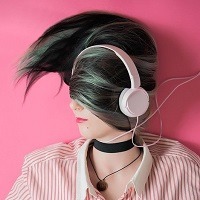 There are many ways to heal with sound. In this article we will be looking at binaural beats therapy – what it is, how it works, what it can be used for and how to go about it plus some safety pointers.
There are many ways to heal with sound. In this article we will be looking at binaural beats therapy – what it is, how it works, what it can be used for and how to go about it plus some safety pointers.
What is Binaural Beats Therapy?
First to understand – what are binaural beats? When two sounds are sent to the brain through earplugs or headphones – one at each ear – and have a slightly different vibrational frequency, they are received separately but simultaneously by the brain. The brain then translates this difference in frequencies into a combined sound – known as a binaural beat.
When the brain is presented with these different sounds and it goes along with them, it produces brainwaves in sync with the binaural beat frequency that it’s “hearing.” This is known as brainwave entrainment and forms the basis of binaural beats therapy.
So how does it work? Different brainwaves are predominant during particular activities as you will see below. By encouraging or entraining the brain to produce particular brainwaves, the aim of binaural beats therapy is to induce a particular behaviour or frame of mind for different purposes – for example, to aid relaxation, meditation, to improve sleep patterns and concentration.
It’s also believed that the benefits of binaural beats therapy include improving the symptoms of Alzheimer’s and dementia, improving the effects of stroke, providing relief for chronic pain sufferers and much more. Although research into the subject has increased dramatically over the last 40+ years, there’s still a long way to go and there are those who would argue it’s simply another load of new age mumbo jumbo!
About Brainwaves…
Different brainwaves can function spontaneously, but in simple terms, the dominant brainwave type will reflect particular behaviours.
The frequency of brainwaves is measured in Hertz (Hz) and although there’s some disagreement over the exact figures, the approximate frequencies of the better known brainwaves are listed below, along with an overview of what happens in their respective states :
Delta Brainwaves (0.5 – 3 Hz)
Brain activity is at one of it’s lowest levels during delta. When these waves  dominate, we are in a state of deepest meditation or dreamless sleep. These brainwaves are important for rejuvenation of the mind and body, and it’s during this state of unconsciousness that the body releases hormones such as serotonin and prolactin. Between them these hormones affect growth, cell reproduction, bone and muscle density, mood, appetite, sexual function and more.
dominate, we are in a state of deepest meditation or dreamless sleep. These brainwaves are important for rejuvenation of the mind and body, and it’s during this state of unconsciousness that the body releases hormones such as serotonin and prolactin. Between them these hormones affect growth, cell reproduction, bone and muscle density, mood, appetite, sexual function and more.
Theta Brainwaves (3 – 8 Hz)
These brainwaves are evident when we sleep, meditate deeply, daydream or perform tasks automatically i.e. driving to work for the 1,000th time. The theta state is a state of reduced consciousness. In the subconscious state, because the senses are “switched off” from external influences there is more of an inwards focus. Whilst awake, we may experience increased moments of free thought flow and creativity as we are disengaged from day to day activities. This type of brain activity is closely linked to learning, memory, intuition and emotional / mental wellbeing.
Alpha Brainwaves (8 – 12 Hz)
These are usually dominant when the mind is resting but alert, for example just before sleep, or in other states of relaxation. During alpha, stress and anxiety levels lessen, we are calm, more capable of mindfulness, more open to creativity and may experience improved memory function. This is a good place to be during meditation or certain yoga practices. Alpha is also good for learning something new or studying; even though brain function is relatively slow, it is easier to maintain a clear focus.
Beta Brainwaves (12 – 38 Hz)
Our usual state of consciousness – when we are actively thinking, attentive, engaged in an activity or conversation and generally connecting fully with the outside world – occurs when beta waves are predominant. These are broken down into 3 further types where various stages of brain stimulation or excitement are experienced. Beta brainwaves are great for problem solving and decision-making, but too much beta activity is believed to increase anxiety levels.
Gamma Brainwaves (38 – 42 Hz / possibly upto 100 Hz)
These are the quickest and have the highest frequency. We know that gamma brainwaves are not fired by neurons, but it’s unknown how they are initiated or powered. These waves dominate when we experience moments of selflessness and pure love. It’s believed that those who experience higher levels of gamma waves are closer on the path towards spiritual enlightenment. When gamma waves dominate, we can experience our highest levels of concentration and mental ability.
The Best Binaural Beats For You
So, in theory, we can train our brain to achieve a particular state, but how can we put this into practice? There are a number of options open to you. YouTube have seemingly endless lists of binaural beat tracks for all manner of things including anxiety, astral projection, abundance, anger, addiction, attracting love, arousal and allergies – and that’s just the a’s. Most I’ve come across so far have a musical overlay, but some will be the beats only – these are usually labelled as “pure.”
For me personally, when I’m writing but having trouble focusing, I listen to music with beta waves. Ideally, when listening to binaural beats, you should be relaxed, in a calm and quiet environment with little or no other noise going on around you. That’s not always possible but I still give it a go. (As well as for concentration, I put the earplugs in to signal to those around me that I don’t want to be disturbed – sometimes it works.)
At night time I’m in that quiet and peaceful zone and I’m usually listening to a guided meditation to encourage theta brainwaves. I like to mix it up a bit so depending on the mood and the day I’ve had, I might opt for tracks focusing on forgiveness, chakra healing, abundance and so on. I usually listen for upto 30 minutes, then I’m ready for sleep. The tracks I listen to on YouTube are all free.
I also recently came across another completely free resource. Through an organisation called Active Meditation you can have full access to their binaural beat meditation library and online courses. There are over 30 meditations and there are some interesting articles on the website. One thing that might put people off is the bible referencing in the blog posts and an optional section of the online courses.
 However, if that bothers you, you can just use the audio meditations and be none the wiser about it. For me it wasn’t a problem, and the organisation itself states clearly that meditation and connection with the higher self is not dependent on religion – it’s there for everyone regardless. Anyway, I’ve dipped my toe in and plan on continuing with Active Meditation, so I’ll keep you posted. Let me know if you give it a go as well.
However, if that bothers you, you can just use the audio meditations and be none the wiser about it. For me it wasn’t a problem, and the organisation itself states clearly that meditation and connection with the higher self is not dependent on religion – it’s there for everyone regardless. Anyway, I’ve dipped my toe in and plan on continuing with Active Meditation, so I’ll keep you posted. Let me know if you give it a go as well.
Are Binaural Beats Safe?
Although there appears to be minimal risk associated with binaural beats therapy, as always, it’s wise to be precautious. According to Dr. Andrew Weil, M.D. :
“Most people have no trouble with binaural beat therapy. However, there’s at least a theoretical chance of running into trouble if you have epilepsy or an irregular heartbeat (especially if you have a pacemaker).”
 As with any form of complementary therapy, there are those that may experience some negative effect(s). For that reason, if you have any known health issues, consult with your G.P. or other relevant professional before undertaking any new practices. This also applies to pregnant women, children, the elderly and vulnerable.
As with any form of complementary therapy, there are those that may experience some negative effect(s). For that reason, if you have any known health issues, consult with your G.P. or other relevant professional before undertaking any new practices. This also applies to pregnant women, children, the elderly and vulnerable.
Obviously common sense has to come into play here as well. For example, don’t attempt to induce delta or theta brainwaves if you are driving or operating machinery. These are the brainwaves that are predominant during our lowest levels of brain activity.
So, the answer – are binaural beats safe? Pretty much, yes. With the right precautions and sensible practice, for most of us, binaural beats and brain entrainment can be a totally harmless and usually enjoyable method of relaxation, stress relief and healing.
Key Points
- Binaural beats therapy is one of the many methods of healing with sound.
- The brain produces a binaural beat when sounds of slightly different frequency are heard by each ear.
- Entrainment is used to encourage the brain to produce a particular brainwave in order to achieve a particular state (e.g. relaxed or focused)
- Predominantly used to ease anxiety, improve concentration, to aid meditation and improve sleep patterns, there are claims that binaural beats therapy can also improve the symptoms of Alzheimer’s and dementia, improve the effects of stroke, and provide relief for chronic pain sufferers.
- This form of therapy is believed to be safe, as long as used with common sense and precaution for those with particular health issues.
So, what do you think? Will you give it a try? I will be continuing with the binaural beats – particularly at night time. I hope you liked this post – it’s a little different to the others, and I’ve enjoyed finding out about this – and other – methods of healing with sound. If you have any questions or comments, please post them below. Thanks.






I have not heard of Binaural Beats Therapy but I may have encountered this type of therapy before. My firstborn just would not sleep every night and I was recommended to on some “special” music to get my baby to sleep better. Somehow, I think it worked. At least, more relaxing for me. Does this fall into Binaural Beats Therapy? Anyway, this is a very good detailed article. I enjoy the read. Thanks.
Hi Sharon, thanks for getting in touch. Music has been used to heal for thousands of years – whether for physical, emotional, mental or spiritual health. I had terrible trouble getting my daughter to sleep when she was about 18 months old and also introduced some very chilled out tunes. These worked wonders. I wasn’t aware of binaural beats back then, and as she wasn’t wearing headphones it definitely wasn’t binaural beats that she was listening to, but the chilled music most certainly calmed her and no doubt encouraged her brain to start relaxing and enter sleepy mode. Thank heavens for music!
This is really interesting. I’d not come across this idea before and it sounds like it could be really beneficial in helping me focus or relax. I think I will definitely have to give it a try using the sites you mention as a starting point. Do you know whether you need to use headphones for it to work, or would playing it through speakers achieve the same effect?
Hi, for binaural beats you will need headphones so that you hear the beats separately and your brain can translate the difference in frequency. However, you can also listen through speakers – the difference here is that they are called “monoaural beats” as the beats have merged into one sound before they are received by your brain. This can also produce different brainwaves and some say it’s more effective than listening to binaural beats.
You might also be interested in the following for focus and relaxation :
https://therapyjet.net/sound-bath-therapy/
https://therapyjet.net/healing-with-solfeggio-frequencies/
Enjoy!
This is very interesting news, although I can’t say I’m too surprised. Supposedly, cats can purr at a certain frequency to help themselves heal. This pretty much seems like the same basic idea.
I may not dive into this too soon yet without doing some more research of my own, But this article for sure has gotten me interested in Binaural Beats.
Great read!
Hi Anthony, thanks for getting in touch. That’s an interesting point about cats – I wasn’t aware that they purred to heal. I agree, it sounds like a very similar idea.
I’m glad you found this article interesting. You might also be interested in some of my other posts on sound healing. Here’s a couple of quick links :
https://therapyjet.net/healing-with-solfeggio-frequencies/
https://therapyjet.net/sound-bath-therapy/
Sound healing is a fascinating subject and we still have so much to learn.
Good luck with the binaural beats research. Would love to hear back from you if you give any sound therapies a try!
Jane